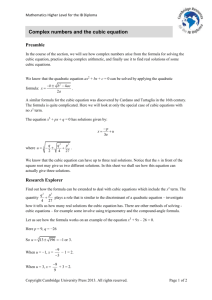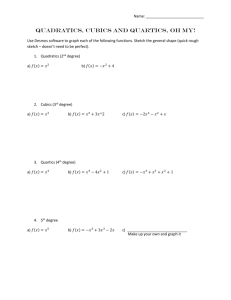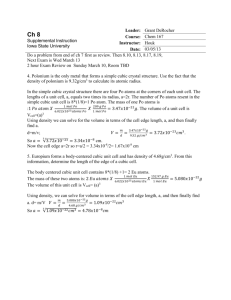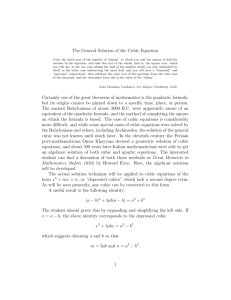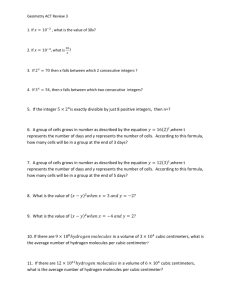Solving Cubics by Division Method
advertisement
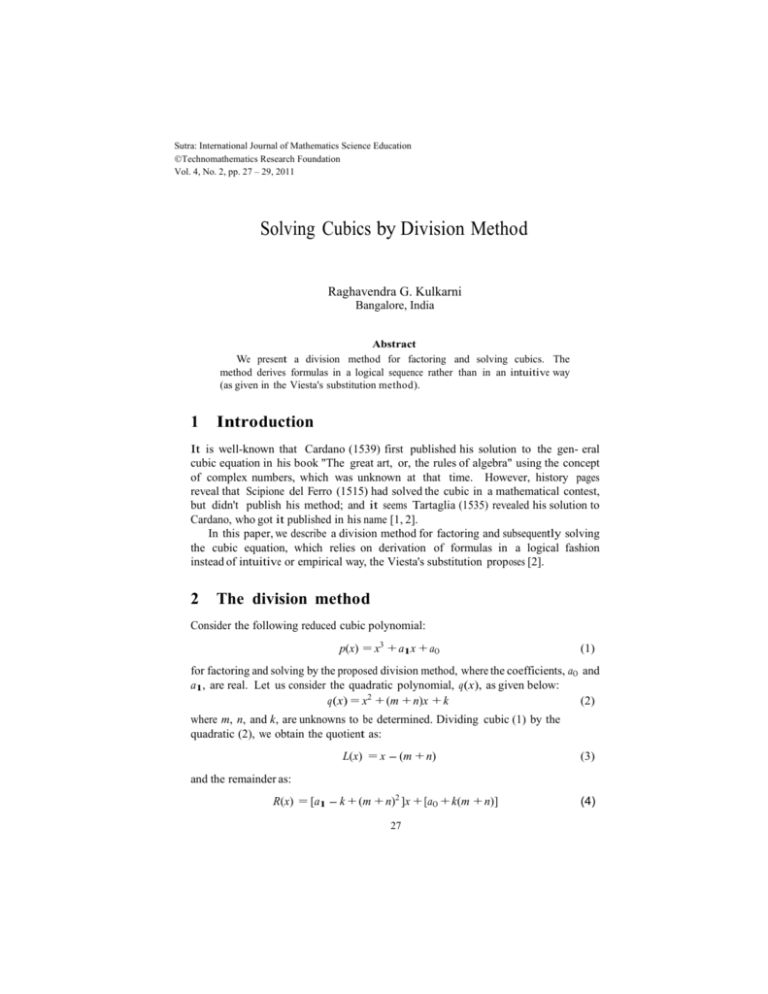
Sutra: International Journal of Mathematics Science Education
Technomathematics Research Foundation
Vol. 4, No. 2, pp. 27 – 29, 2011
Solving Cubics by Division Method
Raghavendra G. Kulkarni
Bangalore, India
Abstract
We present a division method for factoring and solving cubics. The
method derives formulas in a logical sequence rather than in an intuitive way
(as given in the Viesta's substitution method).
1
Introduction
It is well-known that Cardano (1539) first published his solution to the gen- eral
cubic equation in his book "The great art, or, the rules of algebra" using the concept
of complex numbers, which was unknown at that time. However, history pages
reveal that Scipione del Ferro (1515) had solved the cubic in a mathematical contest,
but didn't publish his method; and it seems Tartaglia (1535) revealed his solution to
Cardano, who got it published in his name [1, 2].
In this paper, we describe a division method for factoring and subsequently solving
the cubic equation, which relies on derivation of formulas in a logical fashion
instead of intuitive or empirical way, the Viesta's substitution proposes [2].
2
The division method
Consider the following reduced cubic polynomial:
p(x) = x3 + al x + aO
(1)
for factoring and solving by the proposed division method, where the coefficients, aO and
al , are real. Let us consider the quadratic polynomial, q(x), as given below:
q(x) = x2 + (m + n)x + k
(2)
where m, n, and k, are unknowns to be determined. Dividing cubic (1) by the
quadratic (2), we obtain the quotient as:
L(x) = x - (m + n)
(3)
and the remainder as:
R(x) = [al - k + (m + n)2 ]x + [aO + k(m + n)]
27
(4)
If the quadratic (2) has to be a factor of cubic (1), then the remainder, 𝑅(𝑥),
has to be zero for all values of 𝑥, which means each of the coefficients of 𝑥 and
𝑥0 in 𝑅(𝑥) has to be zero, as shown below.
𝑎1 − 𝑘 + (𝑚 + 𝑛)2 = 0
(5)
𝑎0 + 𝑘(𝑚 + 𝑛) = 0
(6)
Using (6) we eliminate 𝑘 from the expression (5), resulting in a cubic equation
in (𝑚 + 𝑛) as shown below.
(𝑚 + 𝑛)3 + 𝑎1 (𝑚 + 𝑛) + 𝑎0 = 0
(7)
Expanding the above expression and rearranging, we obtain:
𝑚3 + 𝑛3 + (𝑚 + 𝑛)(𝑎1 + 3𝑚𝑛) + 𝑎0 = 0
(8)
Since we have only one equation [(8)] in two unknowns (𝑚 and 𝑛), we require
one more equation to determine the unknowns. Therefore we set 𝑛 as:
𝑛=
−𝑎1
3𝑚
(9)
and use it in (8), which converts (8) into a quadratic equation in 𝑚3 as shown
below.
𝑎3
𝑚6 + 𝑎0 𝑚3 − 1 = 0
(10)
27
Solving (10), we obtain two values of 𝑚3 as:
√
(
)
−𝑎0
1
4𝑎3
3
𝑚 =
±
𝑎20 + 1
(11)
2
2
27
Taking the cube-root of (11), we determine 𝑚 as:
[(
𝑚=
−𝑎0
2
)
1
±
2
√
4𝑎3
𝑎20 + 1
27
]1/3
(12)
Since 𝑚 is already determined, the remaining unknowns [in 𝑞(𝑥)], 𝑛 and 𝑘, are
determined from (9) and (6) respectively. Thus all unknowns in the quadratic
polynomial, 𝑞(𝑥), are determined satisfying the condition that the remainder,
𝑅(𝑥) = 0, for all values of 𝑥. Hence the cubic polynomial, 𝑝(𝑥), can be expressed
as product of its linear [quotient 𝐿(𝑥)] and quadratic [divisor 𝑞(𝑥)] factors as
shown below.
𝑝(𝑥) = 𝐿(𝑥)𝑞(𝑥)
(13)
Equating each of the factors in the above cubic to zero and solving, we obtain
all the three roots of given cubic (1) as shown below.
𝑥1 = 𝑚 −
28
𝑎1
3𝑚
(14)
[
√
(
𝑎1 )
𝑚−
−1 + 1 +
3𝑚
{
[
√
𝑎1 )
1 (
𝑚−
−1 − 1 +
𝑥3 =
2
3𝑚
1
𝑥2 =
2
{
(
(
4𝑎0
𝑚−
)
𝑎1 3
3𝑚
4𝑎0
𝑚−
)
𝑎1 3
3𝑚
]}
(15)
]}
(16)
Let us solve one numerical example using the proposed method. Consider the
cubic equation: 𝑥3 − 2𝑥 + 4 = 0; first, one value of 𝑚3 is determined from (12)
as: −0.0755, and taking its cube-root 𝑚 is determined as: −0.42265. From (17)
one root of cubic is found out as: −2. From (18)√and (19), the other two roots
are determined as: 1 − 1𝑖, and 1 + 1𝑖, where 𝑖 = −1.
3
Conclusions
A division method for solving cubic equation is described, wherein the formulas
are derived in a logical fashion to obtain the three roots of given cubic.
Acknowledgements The author thanks the management of Bharat Electronics Ltd., Bangalore for supporting this work.
References
[1] G. Birkhoff and S. MacLane, ”A survey of modern algebra”, 5th edition,
A. K. Peters, 1997.
[2] Eric W. Weisstein, ”Cubic Equation”, From MathWorld-A Wolfram Web
Resource, http://mathworld.wolfram.com/CubicEquation.html.
329

